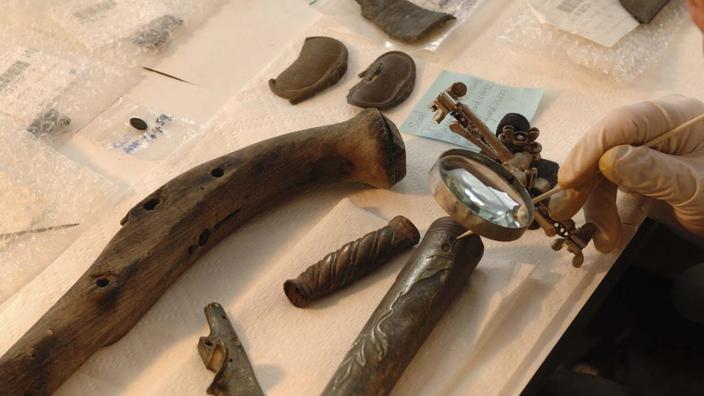Less fantastic than the bewitched pirate buccaneers of the
Pirates of the Caribbean
, but almost as cursed: the human remains of six buccaneers who died in the sinking of the
Whydah
in 1717, were found last week at the wreck site off Wellfleet ( Massachusetts).
About thirty of the 146 crew members taken with the ship - including the remains of Captain Samuel Bellamy (1689-1717), the "Prince of the Pirates" - still escape archaeologists.
To read also: A thousand portholes!
Margot Robbie boarding the
Pirates of the Caribbean
for Disney
Freed from the matrix of marine concretions which imprisoned them while preserving them, the remains are mostly in a bad state, the bones having been broken by the fall of the ship on the seabed.
A complete skeleton has nevertheless been found and should be analyzed in the laboratory of American archaeologists.
Since its location, the wreck has delivered more than 200,000 items to excavators, including nearly 15,000 coins, ranging from Akan gold to a richly decorated flintlock pistol, a vast quantity of common items and up to 'on the ship's bell, engraved with his name.
“
The Whydah stripped 54 different ships, so you're talking about a ship that had cargo and valuables from 54 ships on board.
It's unprecedented in terms of the amount of material on board, including coins and treasures,
”said explorer Barry Clifford, who was responsible for locating the
Whydah
wreck
in 1984 in an interview with CBC. .
Most of the material extracted from the abyss has been on display since 2016 at the Whydah Pirate Museum in West Yarmouth.
Read also: A famous pirate's treasure may have been discovered
Treasure hunt
But even more than the recovery of the many objects and material remains of the wreck, it is the identification of pirates discovered on the spot that is currently mobilizing the attention of American archaeologists.
"We hope that the most modern technologies will help us identify these pirates and reunite them with their possible descendants,"
Barry Clifford
told
CBS Boston
.
In their sights: the identification, one day maybe, of the remains of Captain Bellamy - says Black Sam, "The Prince of the Pirates".
A comparative analysis of the DNA of a descendant of the English pirate had already made it possible to rule out a first remains, discovered in 2018.
Read also: The disturbing return of pirates in the Gulf of Guinea, the most dangerous maritime area in the world
In a ranking made in 2008,
Forbes
had named Samuel Bellamy as "
the richest pirate of all time
", with a loot estimated at nearly 120 million dollars.
One of his greatest feats of arms had been the capture in February 1717 of the
Whydah
, an English slave ship - named after the current port of Ouidah, in Benin - which was then carrying more than four and a half tons of gold and silver from Jamaica.
Bellamy and the
Whydah
sank shortly thereafter in a nighttime storm on April 26, 1717.
Very heterogeneous, the crew of the
Whydah
was made up for almost a third of former slaves.
Together, they “were
experimenting with democracy long before so-called civilized societies considered such a thing,
” Barry Clifford told the
Boston Herald
, recalling the horizontal counter-culture, based on a voting system and an equal distribution of loot, which was common in these pirate companies.
The sinking of the
Whydah
and her crew came at the end of the Golden Age of piracy, just before the effects of the Peace of Utrecht - ending the War of the Spanish Succession - brought it to an abrupt end. a term in the years 1716-1726.

